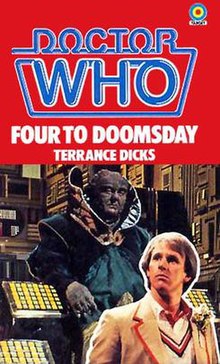Plot
This episode's plot summary may be too long or excessively detailed.(June 2017) |
The TARDIS materialises on board a vast and advanced spacecraft, observed by a hovering surveillance device which conveys the arrival of the crew to an observing being in control of the vessel. The TARDIS crew become separated and the Fifth Doctor and Tegan reach the bridge where the green-skinned commander introduces himself as Monarch, ruler of Urbanka, and his associates and fellow Urbankans are the Ministers of Enlightenment and Persuasion. The leader is intrigued by talk of current Earth civilisation and reveals their ship is bound for Earth. Shortly afterwards Enlightenment and Persuasion assume human forms, dressed in garments Tegan designed to demonstrate contemporary Earth fashions.
The TARDIS crew are reunited as guests, and it becomes apparent that there are four distinct human cultures represented on the vessel by a small group of humans – Ancient Greeks, the leader of whom is the philosopher Bigon; Chinese Mandarins and their leader Lin Futu; Princess Villagra and representatives of the Maya peoples; and Kurkutji and his tribesmen, of a very ancient Australian Aboriginal culture. The Urbankans have made periodic visits to Earth, each time getting speedier in their journeys. This time they have left their homeworld after erratic solar activity, storing three billion of their species on slides aboard their craft. It seems that the current journey is their last and that they now wish to settle on Earth, which they are due to reach in four days.
The Doctor becomes suspicious of Monarch and soon learns he does not plan on peaceful co-existence. Instead, he has developed a poison that reduces the intended in size to conquer Earth, which will be unleashed before the Urbankans disembark. He also learns that the humans aboard are not descendants of the original abductees, but are the original people taken from Earth and converted into androids, like the three Urbankans walking around on board. Monarch describes the era prior to his conversion of Urbankan life forms into cyborgs as the "flesh-time". The four leaders of the peoples have been given additional circuits to help them reason, but this facility can be taken away, as Bigon learns when he rebels against Monarch, and his neural circuit is removed and placed in a container for one hundred years. He explained to the Doctor that Monarch strip-mined and polluted Urbanka in a quest for minerals to improve the ship, and now plans to do the same to Earth. Monarch believes that if he can move the ship faster than the speed of light, he can pilot it back to the beginning of time and discover himself as God.
Adric, nevertheless, is rather taken with Monarch, and tensions between him and the Doctor become very strained. It takes The Doctor to break the tyrant's hold over the boy. The Doctor now sets about overthrowing Monarch and, with the help of the human androids led by a restored Bigon, a revolution is put into effect. Enlightenment and Persuasion are decircuited, while Monarch himself (whom the Doctor realises is still organic as there is an oxygen-producing flora chamber on the ship) is exposed to the poison and shrunk. The humanoid androids decide to pilot the vessel to a new home on a new world, while the TARDIS crew departs. Back in the console room, Nyssa suddenly collapses to the floor in a dead faint.








